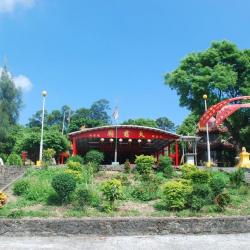The stone lion base in front of the Tianjun Temple was originally the x base for the stone lanterns of Kotohira Shrine. The pair of stone lanterns from the Kotohira Shrine was moved to both sides of the entrance of the Tianjun Temple. Therefore, the remaining base was painted yellow and a small stone lion was placed on it. The age and the name of the donor can still be seen on the base. The left and right bases have the engraving of "Showa 6th Year" (1931) and "Showa 4th Year" (1929) respectively, which clearly prove that they belong to the Kotohira Shrine.
Indigene Management Route
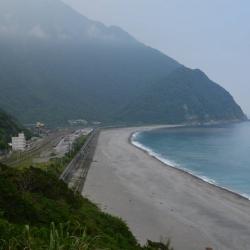
The image shows Heren hamlet in the distance, a view from the Suhua Highway. The hamlet belongs to the Truku tribe and is located on the left bank terrace of the Liangli River estuary. It sits 45 meters above sea level, faces the Pacific Ocean in the east, mountains in the west, Liangli River and Chongde village in the south, and is 4 kilometers adjacent to the Hezhong community in the north. The original hamlet, Btakan-she, was established on the mountainside opposite the current location and was only moved to the current location after the Japanese occupation. Truku people named the hamlet “Qnragan", which later on becomes "Qnagan". It means bare trees because when the tribesmen first arrived here, it was so windy that trees were blown down, and leaves were falling that making them bare. During the Japanese rule, some tribes such as Skadang, Squrxan, Bmux, Quwis, Lapax moved into the hamlet. At the end of the Japanese rule, the people relocated to what is today’s Zhihezhong community. After the war, they moved back but west of the current location and named it Heren. In 1948 the hamlet got washed away by a typhoon and so the people moved to the present site.
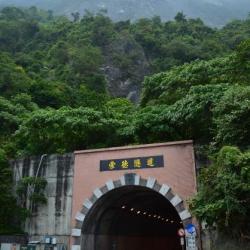
The Chongde Tunnel was opened to traffic on August 10, 1990, with a total length of about 325 meters. The Shigangzai section of Suhua Historic Trail still remains above the tunnel and can be reached from the south end of Chongde Tunnel. In 2012, it was attacked by moderate typhoon Sula, and the area for car parking at the south end of the tunnel was washed away due to heavy rain.
The Shigangzai section of the Suhua Historic Trai belongs to the Taroko National Park and is temporarily closed, and due to the rapid climate change in recent years, the Taroko National Park Headquarters has no restoration plan. This trail is one of the coastal Lifan roads excavated in the 3rd year of Taisho (1914). Today, there are still complete stone steps along the way, where you can overlook the Qingshui cliff.
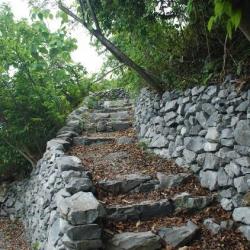
The investigation by Yang Nanjun, an ancient trail researcher, confirmed that the preservation of the North Suhua Historic Trail was not as good as the other two trails. The main reason is that most of the uphill and downhill sections use timber steps, which are more prone to decay. Also, with the defense and attack of indigenous people, officials and others tend to take the safer sea route.
After his investigation, the Shigangzi trail between the south entrance of the Chongde Tunnel and Shigangzi is the most complete. Yang pointed out that the average width of the Shigangzai trail is 120 cm, and there are lower ridges at the cliffs. One of the broken rock zones is paved with stones to form a flat road with a width of 180 cm. It is one of the important landscape assets of Taroko National Park to provide a view of Qingshui Cliff directly into the Pacific Ocean.
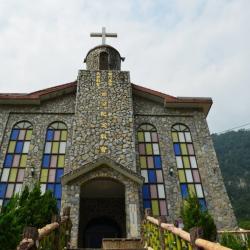
Ciwang.Iwal (1872-1946) was the first Truku Christian to be baptized. When Ciwan was in trouble, she met Li Shuiche of the Hualien Port Church who preached the gospel to her. In June of the 13th year of Taisho (1924), she was baptized by Pastor Liu Junchen of the Hualien Port Church and became the first Christian of the Truku tribe. In the 4th year of the Showa era (1929), when Pastor Sun Yage, a missionary, went to the east, he personally brought Ciwang to Tamsui Women's Bible College for theological training. After graduation, she returned home to preach the gospel to her people. After Ciwang passed away, a proposal was put forward in 1958 to set up a Memorial Church in Fushi Village. The proposal got approved, and fundraising began. With the sponsorship of various churches and foreign believers, the construction was completed in the summer of 1961. The inauguration ceremony was held on November 29 of the same year. It was named Ciwang Memorial Church.
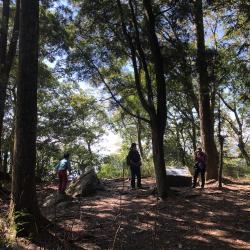
The Wantian Battery, in Tai'an Township of Miaoli County, was set up for the Government-General in Taiwan to monitor the northern Atayal group. The battery was erected on the ridge line or highest point of the mountain overlooking tribal villages in order to intimidate indigenous people.
In the early days of Japanese rule, the governor of Taiwan, Sakuma Samata organized a large-scale crusade to manage the indigenes. In 1911, he suppressed the northern group of Atayal tribe with superior force. Police Officer, Maruda Kiyoshi, was killed during this fight and therefore, the battery was named after him.
Today, the remains of the Wantian Battery are hidden in the forest of Cryptomeria. The stone road that leads to the battery from Erbensong Police Post was mainly used to transport food and firearms supplies.
Jinlun Hamlet is located on the alluvial plain on the north bank of the Jinlun River estuary in Taimali Township, Taitung County. The traditional Paiwan name for the place is Kanaron, which was named after the abundant rosary pea plants there. It can also be called Hanzilun or Jiazinan. Jinlun hamlet existed as early as the Dutch colonial period, and once participated in the Eastern Local Conference held in Beinan in 1655. Due to its ideal location at the mouth of Jinlun River, it was an important place to dispatch coastal defense troops to garrison during the Qing period. During the Japanese occupation, police post, education center, and trade center were also set up there.
Liqiu Hamlet, located in Jinfeng Township, Taitung County, was formed by the amalgamation of three settlements: Rulakes’she, Chushuiposhe, and Jiajiaduowanshe. At the end of the Japanese occupation, the Government-General in Taiwan enforced a collective migration into Rulakes’she. After the war, the National Government re-named the hamlet to Liqiu, which became the largest hamlet in Jinfeng Township.
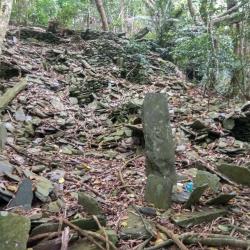
Zhuyege Hamlet is located in Jinfeng Township, Taitung County. The hamlet sits on the gentle slope of the Dalili Mountain ridge, about 525 meters above sea level. At the end of the Qing period, due to the farming of the land in the Zhuyegeshe, some of the tribesmen moved to the southern side on the right bank of Nabao River and built a new hamlet near Huangshe. Later, the tribesmen migrated away from the hamlet and formed Daoweilaoshe and Nabaoshe. In the early days of Japanese rule, the tribes of Zhuyegeshe moved to the vicinity of Huangshe. In the early post-war period, the National Government moved all the tribesmen near Huangshe to the mountain reservation land in Beili Village, Taimali Township. The hamlet was rebuilt and its name was changed to Xinxing Village.
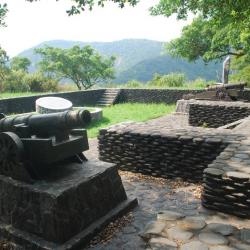
Paotaishan (Fort Mountain) is located on the 105 km way of Provincial Highway 9 in the south in Su’ao Township, Yilan County, at an altitude of about 200 meters. It was built in 1884 when the Qing-French War broke out. The French army attacked Su’ao; and the Blue Cap commander Chen Hui-huang took advantage of the superior terrain of Paotaishan and carried cannons up the mountain with the help from local residents. The fortress and barracks were built there in consideration of the military fortress, and hence, the name “Paotaishan” (Fort Mountain) came about.
To this day, the six hundred-strand front chamber cast iron guns are stored in the warehouse of the Su’ao Township Office.
